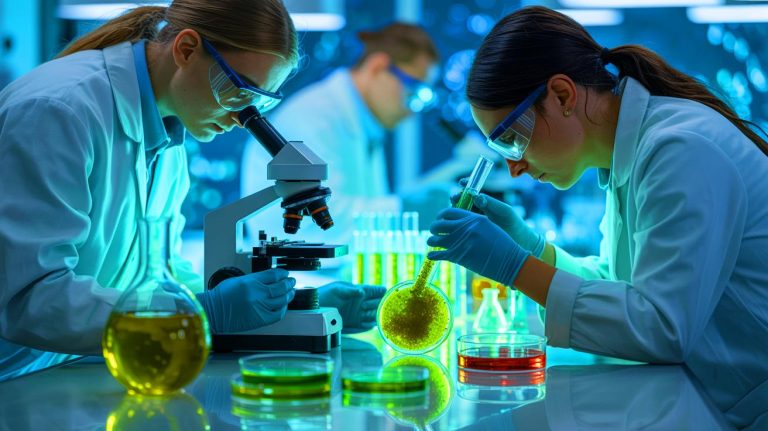| IN A NUTSHELL |
|
In an extraordinary scientific breakthrough, researchers have successfully revived microalgae that have been dormant for nearly 7,000 years, lying buried in the sediments of the Baltic Sea. This remarkable achievement not only opens a window into the ancient marine world but also offers fresh perspectives on the resilience and adaptability of life forms amid changing environmental conditions. Detailed in The ISME Journal, the study underscores the potential of leveraging ancient biological data to forecast future ecological shifts in response to climate change.
Understanding the Dormant Microalgae
Microalgae, specifically the diatom Skeletonema marinoi, have long fascinated scientists due to their ability to survive in dormancy over vast time spans. These organisms were retrieved from different sediment layers in the Baltic Sea, where they had lain without light or oxygen for thousands of years. By reviving these algae, researchers are able to study living specimens from ancient ecosystems, offering insights beyond what fossils can provide.
Genetic analysis of the revived algae indicates significant adaptation over millennia. Despite their ancient origins, these algae resumed typical photosynthetic activity upon revival, suggesting robust biological resilience. This research, which employs resurrection ecology, allows scientists to examine historical environmental conditions encapsulated within marine sediments, acting as a biological time capsule.
Implications for Future Climate Research
The successful revival of these ancient algae provides a unique opportunity to understand how marine life has historically responded to climate changes. By studying these ancient strains, researchers can compare them to modern counterparts to gauge the impacts of past climate shifts on phytoplankton populations. This understanding is crucial for predicting how current and future climate changes might influence marine ecosystems.
The study highlights the critical role of sediments in tracing the genetic lineage of species. Future research is set to explore specific evolutionary adaptations that have occurred over thousands of years. Such insights are vital for developing models to predict the responses of marine life to ongoing environmental changes.
The Role of Dormancy in Survival
The concept of dormancy as a survival strategy is widespread in nature, allowing organisms to withstand unfavorable conditions. In the case of microalgae such as Skeletonema marinoi, dormancy involves forming specialized cells equipped with thick walls and energy reserves. These dormant phases enable survival without light, oxygen, or in extreme temperatures.
Unlike simple hibernation, dormancy involves complex physiological changes, including the production of protective proteins. These adaptations are often linked to seasonal cycles, with cells descending into the sediments during winter and re-emerging in spring. The ability of some strains to remain dormant for millennia raises intriguing questions about the limits of life’s endurance.
Exploring New Research Frontiers
The revival of ancient microalgae challenges our understanding of biological longevity and resilience. Key questions remain about how these organisms maintain cellular integrity over such long periods and whether their repair mechanisms remain functional. These inquiries drive the field of resurrection ecology, which uses these algae as models to study extreme longevity and adaptability.
This line of research not only enhances our understanding of marine biology but also offers broader implications for climate resilience and biodiversity conservation. As scientists continue to unravel the mysteries of these ancient life forms, they may uncover strategies for safeguarding ecosystems in a rapidly changing world.
The revival of these ancient organisms prompts us to reflect on the broader implications for our planet’s future. How can these findings inform our approaches to biodiversity preservation amid climate change? The answers may be hidden in the depths of our oceans, waiting to be uncovered.
Did you like it? 4.6/5 (20)







Wow, 7,000 years old? That’s older than my grandmother’s cookie recipe! 🍪
Could this help us understand past climate changes more accurately?
This is like sci-fi coming to life! What’s next, dinosaurs? 🦖
Are there any ethical concerns with reviving ancient life forms?
The resilience of these organisms is mind-blowing. Nature never ceases to amaze!
How do scientists ensure these revived algae don’t pose a threat?
7,000 years is impressive, but can they survive my daily commute? 🚗
This could provide valuable insights into species’ evolution over millennia.
How exactly do scientists determine the age of these microalgae?
Reviving ancient algae? What’s next, time travel? ⏳
Is there a chance that these organisms could have medicinal properties?
Does this mean ancient algae could adapt to modern environmental conditions?
I have a hard time keeping my fish alive for a week, let alone 7,000 years! 🐟
What are the potential applications of this discovery in biotechnology?
It’s amazing how life finds a way, even in darkness for millennia.
This feels like Jurassic Park, but for algae! Should we be worried? 🦕
Could this lead to breakthroughs in understanding climate change resilience?
How do they ensure the genetic integrity of these revived organisms?
Are there any plans to study other ancient marine organisms in a similar way?
This could revolutionize our understanding of climate resilience. Thank you for sharing!
This discovery is as astonishing as it is mysterious. Great work!
I guess nature’s way of hiding secrets is more effective than ours. 🔍
Can these algae offer insights into marine life’s adaptability to climate change?
What other potential ancient organisms are scientists looking to revive?
So, could this lead to new conservation strategies for endangered species?
Does this mean they could potentially revive other ancient organisms too?
I don’t know if I should be impressed or terrified. 😳